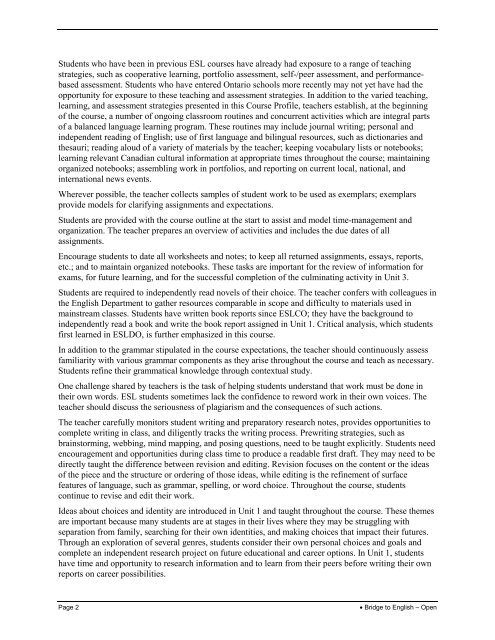Course Profile - Curriculum Services Canada
Course Profile - Curriculum Services Canada
Course Profile - Curriculum Services Canada
Create successful ePaper yourself
Turn your PDF publications into a flip-book with our unique Google optimized e-Paper software.
Students who have been in previous ESL courses have already had exposure to a range of teaching<br />
strategies, such as cooperative learning, portfolio assessment, self-/peer assessment, and performancebased<br />
assessment. Students who have entered Ontario schools more recently may not yet have had the<br />
opportunity for exposure to these teaching and assessment strategies. In addition to the varied teaching,<br />
learning, and assessment strategies presented in this <strong>Course</strong> <strong>Profile</strong>, teachers establish, at the beginning<br />
of the course, a number of ongoing classroom routines and concurrent activities which are integral parts<br />
of a balanced language learning program. These routines may include journal writing; personal and<br />
independent reading of English; use of first language and bilingual resources, such as dictionaries and<br />
thesauri; reading aloud of a variety of materials by the teacher; keeping vocabulary lists or notebooks;<br />
learning relevant Canadian cultural information at appropriate times throughout the course; maintaining<br />
organized notebooks; assembling work in portfolios, and reporting on current local, national, and<br />
international news events.<br />
Wherever possible, the teacher collects samples of student work to be used as exemplars; exemplars<br />
provide models for clarifying assignments and expectations.<br />
Students are provided with the course outline at the start to assist and model time-management and<br />
organization. The teacher prepares an overview of activities and includes the due dates of all<br />
assignments.<br />
Encourage students to date all worksheets and notes; to keep all returned assignments, essays, reports,<br />
etc.; and to maintain organized notebooks. These tasks are important for the review of information for<br />
exams, for future learning, and for the successful completion of the culminating activity in Unit 3.<br />
Students are required to independently read novels of their choice. The teacher confers with colleagues in<br />
the English Department to gather resources comparable in scope and difficulty to materials used in<br />
mainstream classes. Students have written book reports since ESLCO; they have the background to<br />
independently read a book and write the book report assigned in Unit 1. Critical analysis, which students<br />
first learned in ESLDO, is further emphasized in this course.<br />
In addition to the grammar stipulated in the course expectations, the teacher should continuously assess<br />
familiarity with various grammar components as they arise throughout the course and teach as necessary.<br />
Students refine their grammatical knowledge through contextual study.<br />
One challenge shared by teachers is the task of helping students understand that work must be done in<br />
their own words. ESL students sometimes lack the confidence to reword work in their own voices. The<br />
teacher should discuss the seriousness of plagiarism and the consequences of such actions.<br />
The teacher carefully monitors student writing and preparatory research notes, provides opportunities to<br />
complete writing in class, and diligently tracks the writing process. Prewriting strategies, such as<br />
brainstorming, webbing, mind mapping, and posing questions, need to be taught explicitly. Students need<br />
encouragement and opportunities during class time to produce a readable first draft. They may need to be<br />
directly taught the difference between revision and editing. Revision focuses on the content or the ideas<br />
of the piece and the structure or ordering of those ideas, while editing is the refinement of surface<br />
features of language, such as grammar, spelling, or word choice. Throughout the course, students<br />
continue to revise and edit their work.<br />
Ideas about choices and identity are introduced in Unit 1 and taught throughout the course. These themes<br />
are important because many students are at stages in their lives where they may be struggling with<br />
separation from family, searching for their own identities, and making choices that impact their futures.<br />
Through an exploration of several genres, students consider their own personal choices and goals and<br />
complete an independent research project on future educational and career options. In Unit 1, students<br />
have time and opportunity to research information and to learn from their peers before writing their own<br />
reports on career possibilities.<br />
Page 2<br />
• Bridge to English – Open

















